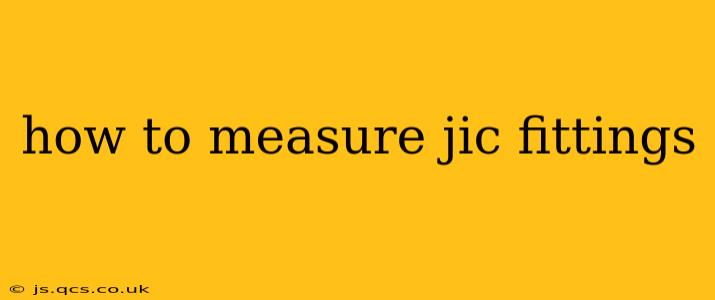JIC (Joint Industry Council) fittings are a crucial component in many hydraulic and pneumatic systems, known for their robust design and leak-proof connections. Properly measuring these fittings is essential for ensuring a secure and effective connection. This guide will walk you through the critical measurements needed, common mistakes to avoid, and best practices for accurate measurement.
What are the Key Measurements of a JIC Fitting?
The key dimensions of a JIC fitting are:
-
Pipe Size (OD): This refers to the outside diameter of the tube or pipe that the fitting will connect to. JIC fittings are specified by their pipe size, usually expressed in inches (e.g., 1/4", 3/8", 1/2"). This is the most crucial measurement. Never assume the pipe size; always measure it directly.
-
Thread Size and Type: JIC fittings utilize a specific type of thread, which is crucial for proper mating. The thread size is typically denoted in inches (e.g., 1/4"-18 NPTF). The "NPTF" designation signifies National Pipe Taper Fuel, which is a tapered thread specifically designed for hydraulic applications.
-
Overall Length: The total length of the fitting, from the end of the male or female connector to the other end. This measurement is important for determining the overall space requirements of your hydraulic system.
-
Shoulder Diameter/Hex Size (for nut): If dealing with a nut, its hexagonal size is important for selecting the correct wrench. For male connectors, the shoulder diameter affects the fitting’s overall size and installation space.
How to Measure JIC Fitting Pipe Size (OD) Accurately
Measuring the pipe size (outer diameter) is the most critical step. Here’s how to do it correctly:
-
Use a reliable measuring tool: A digital caliper is ideal for precise measurements, offering accuracy to the thousandth of an inch. A good quality micrometer can also be used. Avoid using a standard ruler, which lacks the precision needed.
-
Clean the surface: Ensure the pipe or fitting is clean and free from debris, as any dirt or imperfection could skew the reading.
-
Multiple measurements: Take multiple measurements at different points along the pipe's circumference to ensure accuracy and account for any minor variations in diameter.
-
Record the average: Calculate the average of your measurements to obtain the most accurate representation of the pipe size.
What About the JIC Fitting Threads?
While you'll need the right tools (thread pitch gauge) to accurately identify the JIC thread specifications, visually inspecting the threads and comparing it to your existing system will often be sufficient for ensuring compatibility. If you’re unsure, consulting a professional or referring to a JIC fitting catalog is highly recommended.
How to Determine the JIC Fitting's Overall Length
This measurement is straightforward, using the caliper or ruler to measure from the end of one connector to the end of the other. Remember to measure along the fitting’s center axis for the most accurate measurement.
Identifying the Shoulder Diameter or Nut Hex Size
For the shoulder diameter or the hex size, use a caliper to measure across the flat sides of the fitting’s shoulder (for a male connector) or the nut. A ruler can be used but will be less precise.
Common Mistakes to Avoid When Measuring JIC Fittings
-
Using the wrong tools: Avoid relying on imprecise measuring tools like rulers or tape measures. Digital calipers and micrometers provide much higher accuracy.
-
Ignoring the thread type: Don’t just focus on the thread size, ensure the thread type is NPTF. Using the wrong type will lead to leaks and damage.
-
Taking only one measurement: Always take multiple measurements to account for possible irregularities or variations.
-
Neglecting cleanliness: A dirty fitting surface can lead to inaccurate measurements.
Understanding JIC Fitting Standards (Frequently Asked Questions)
This section addresses common questions surrounding JIC fitting measurements and standards.
What is the difference between JIC and NPT?
JIC (Joint Industry Council) and NPT (National Pipe Taper) are both types of pipe threads, but they have key differences. JIC fittings are designed for higher pressures and offer better sealing capabilities due to their 37° cone-shaped threads and special sealing techniques. NPT threads are less precise and are typically used in lower-pressure applications.
Are JIC fittings metric or imperial?
JIC fittings are primarily imperial, using inches to specify dimensions.
How important is the sealing ring (O-ring) in JIC fittings?
The O-ring is critical for creating a leak-proof seal. Proper fitting selection and installation, including the correct O-ring, are paramount.
Where can I find a JIC fitting catalog?
Many hydraulic and pneumatic component suppliers offer catalogs that list JIC fitting specifications. You can also find resources online from reputable manufacturers and distributors.
By following these guidelines and paying close attention to detail, you can accurately measure JIC fittings and ensure the integrity of your hydraulic or pneumatic system. Remember, precision is paramount when dealing with high-pressure systems. If you are unsure about any aspect of this process, always consult a qualified professional.
